Intravenous (IV) catheters, also known as "IV lines," can be an important part of your child's care. Keeping your child safe when they require an IV line is important to your child's healthcare providers. A child's safety is reinforced when parents and caregivers are informed and involved in their care.
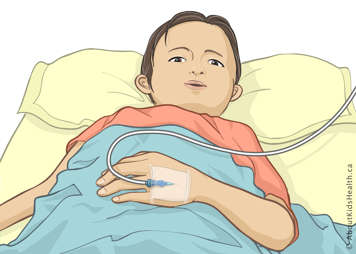
What is an IV line?
IV lines are used to deliver different types of fluids, medications, and blood products to patients of all ages. The catheter or the "line" is a thin, flexible plastic tube. A trained health care provider inserts the line into a vein in the hand, arm, foot, leg, or scalp. Fluid flows through the line directly into the child's bloodstream.
Inserting an IV line
An IV line has a small needle inside the tube that helps get the tube into the vein. When the nurse or doctor inserts the needle and the surrounding tube into the vein, the needle is pulled out and the plastic tube stays in place. This area of the body where the IV line is inserted is known as the "IV site." Your child may feel a small pinch when the needle is inserted, but the pain will go away once the needle is removed. The IV line is held in place at the insertion site with clear tape.
Why is it important to care for an IV line?
IV lines can become dislodged or blocked and stop working, which is why it is extremely important to ensure that the IV line is protected and well-cared for. These lines allow medications, fluids, and even blood to enter the body, a necessary part of your child's medical care. Proper IV-line care reduces the risk of complications associated with IV lines.
Caring for an IV line
Intravenous lines must be properly checked and cared for to ensure the line is working properly and that there are no complications. It is the nurse's responsibility to ensure IV line safety, but parents and caregivers can assist in IV care by monitoring the line when the nurse is not present and alerting the nurse to any problems or concerns.
What your nurse will do to care for the IV line
It is the nurse's responsibility to check the IV site at least once every hour, including throughout the night.
Nurses will treat your child's IV line with TLC+1, meaning they will do the following:
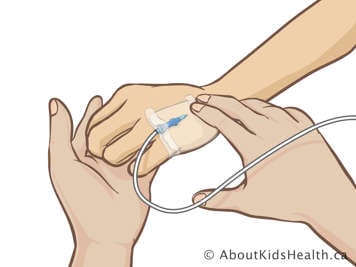
TOUCH for signs of temperature change (heat or warmth) or leakage at the IV site.
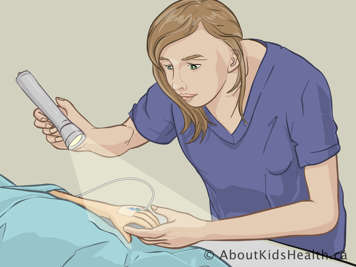
LOOK to make sure the IV site is dry and visible at all times.
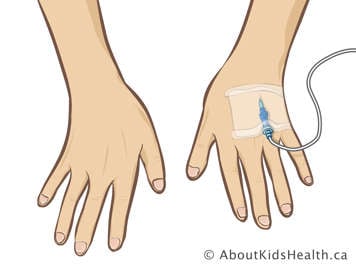
COMPARE the IV site (such as the hand or leg) with the opposite limb to look for signs of swelling.

+ENGAGE with patients, parents, and caregivers to ensure the best possible care. This means encouraging patients and families to:
- notify the nurse if they notice any symptoms of complications (outlined below)
- ask questions or share concerns
- assist and support nurses caring for the IV line.
Nurses will try to minimize disruptions when checking the IV line (such as using a flashlight at night), but for safety reasons they must check the site, even when your child is asleep.
What YOU can do to care for the IV line
Parents and caregivers can help care for the IV line when the nurse is not around by doing the following:
- Help protect the IV line. Sometimes an IV line can accidentally come out if it is bumped. Make sure the IV line does not get pulled when your child is walking, playing, using the bathroom, or getting up from a bed or chair. Ask a nurse if you need help managing the IV line during these activities.
- Speak with your child. Ask your child to tell you if the IV line hurts, or if the IV site feels tingly or numb. Remind them not to pull or tug on the IV line and to ask the nurses for help if they want to move.
- Keep IV site visible (especially when your child is sleeping). This will make it easier for the nurse to check the IV without waking your child.
- Keep the IV site dry. The IV site should be kept dry at all times. This helps prevent infection and accidental IV line removal.
- Call the nurse if you notice any signs of complications. These are outlined below.
Complications
If an IV line is not working properly, your child may experience any of the following symptoms:
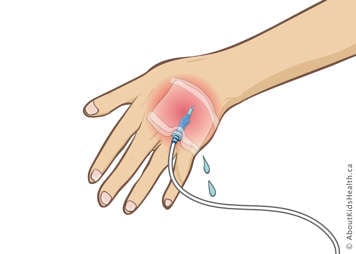
- General pain or pain to the touch at the IV site
- Swelling of the area where the IV line is inserted
- Numbness at the area
- Redness
- Bruising
- Wetness at the area, suggesting that the IV line is leaking
- Firmness at the area, which may be related to swelling
- Warmth or coolness at the IV site
The hourly assessments done by the nursing staff will ensure the IV line is working properly or let them know if there are problems.
What happens if an IV line is pulled out?
If your child's IV line is accidentally pulled out, call the nurse for help. While you are waiting, apply pressure to the area (where the IV line used to be) using gauze or tissue to stop any bleeding. Hold on to the IV line until the nurse arrives.
What happens if the IV line stops working?
If the IV line is not working properly, the fluid in the IV may leak into the surrounding tissues. Your child may experience some of the symptoms described above (e.g., pain, swelling). The IV line may need to be restarted, reinserted or switched if it is not working or if it has been accidentally removed. In this situation, your child's nurse or doctor will talk to you about the next course of action.
Parents and caregivers can speak to their nurse at any time if they have questions or concerns about the IV line.
1TLC+ adapted with permission from Cincinnati Children's TLC (Touch, Look, Compare) policy for peripheral intravenous catheter care.